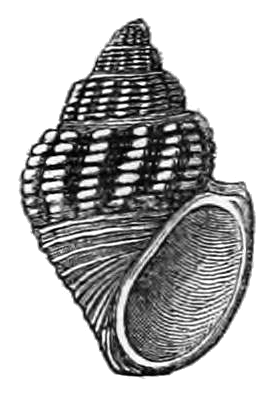Paramelania Damoni on:
[Wikipedia]
[Google]
[Amazon]
''Paramelania damoni'' is a
 ''Paramelania crassigranulata'' was recognized as a form of this species by Brown (1994).Brown D. S. (1994). ''Freshwater Snails of Africa and their Medical Importance''.
''Paramelania crassigranulata'' was recognized as a form of this species by Brown (1994).Brown D. S. (1994). ''Freshwater Snails of Africa and their Medical Importance''.
species
In biology, a species is the basic unit of classification and a taxonomic rank of an organism, as well as a unit of biodiversity. A species is often defined as the largest group of organisms in which any two individuals of the appropriate s ...
of tropical
The tropics are the regions of Earth surrounding the Equator. They are defined in latitude by the Tropic of Cancer in the Northern Hemisphere at N and the Tropic of Capricorn in
the Southern Hemisphere at S. The tropics are also referred to ...
freshwater snail
Freshwater snails are gastropod mollusks which live in fresh water. There are many different families. They are found throughout the world in various habitats, ranging from ephemeral pools to the largest lakes, and from small seeps and springs ...
with an operculum, an aquatic gastropod
The gastropods (), commonly known as snails and slugs, belong to a large taxonomic class of invertebrates within the phylum Mollusca called Gastropoda ().
This class comprises snails and slugs from saltwater, from freshwater, and from land. T ...
mollusk
Mollusca is the second-largest phylum of invertebrate animals after the Arthropoda, the members of which are known as molluscs or mollusks (). Around 85,000 extant species of molluscs are recognized. The number of fossil species is e ...
in the family Paludomidae
Paludomidae, common name paludomids, is a family of freshwater snails, gastropod molluscs in the clade Sorbeoconcha.
Distribution
The distribution of the Paludomidae includes Asia and Africa.
Taxonomy
The following three subfamilies have be ...
.
The specific name ''damoni'' is in honor of Robert Damon
Robert Damon (1814 – 4 May 1889) was an English conchologist and geologist.
Damon was at first a hosier and glover but with his son Robert Ferris Damon (1845–1929) he established a dealership in natural history specimens in Weymouth. T ...
from Weymouth, who collected the type specimen.
Distribution
The distribution of this species includesLake Tanganyika
Lake Tanganyika () is an African Great Lake. It is the second-oldest freshwater lake in the world, the second-largest by volume, and the second-deepest, in all cases after Lake Baikal in Siberia. It is the world's longest freshwater lake. ...
in Burundi
Burundi (, ), officially the Republic of Burundi ( rn, Repuburika y’Uburundi ; Swahili language, Swahili: ''Jamuhuri ya Burundi''; French language, French: ''République du Burundi'' ), is a landlocked country in the Great Rift Valley at the ...
, the Democratic Republic of the Congo
The Democratic Republic of the Congo (french: République démocratique du Congo (RDC), colloquially "La RDC" ), informally Congo-Kinshasa, DR Congo, the DRC, the DROC, or the Congo, and formerly and also colloquially Zaire, is a country in ...
, Tanzania
Tanzania (; ), officially the United Republic of Tanzania ( sw, Jamhuri ya Muungano wa Tanzania), is a country in East Africa within the African Great Lakes region. It borders Uganda to the north; Kenya to the northeast; Comoro Islands and ...
, and Zambia
Zambia (), officially the Republic of Zambia, is a landlocked country at the crossroads of Central Africa, Central, Southern Africa, Southern and East Africa, although it is typically referred to as being in Southern Africa at its most cent ...
.
The type locality is Lake Tanganyika
Lake Tanganyika () is an African Great Lake. It is the second-oldest freshwater lake in the world, the second-largest by volume, and the second-deepest, in all cases after Lake Baikal in Siberia. It is the world's longest freshwater lake. ...
.
Description
''Paramelania damoni'' was originally described byEdgar Albert Smith
Edgar Albert Smith (29 November 1847 – 22 July 1916) was a British zoologist, a malacologist.
His father was Frederick Smith, a well-known entomologist, and assistant keeper of zoology in the British Museum, Bloomsbury. Edgar Albert Smith w ...
in 1881. Smith's original text (the type description
A species description is a formal description of a newly discovered species, usually in the form of a scientific paper. Its purpose is to give a clear description of a new species of organism and explain how it differs from species that have be ...
) reads as follows:
The width of the shell is 28 mm. The height of the shell is 37 mm.
 ''Paramelania crassigranulata'' was recognized as a form of this species by Brown (1994).Brown D. S. (1994). ''Freshwater Snails of Africa and their Medical Importance''.
''Paramelania crassigranulata'' was recognized as a form of this species by Brown (1994).Brown D. S. (1994). ''Freshwater Snails of Africa and their Medical Importance''. Taylor & Francis
Taylor & Francis Group is an international company originating in England that publishes books and academic journals. Its parts include Taylor & Francis, Routledge, F1000 (publisher), F1000 Research or Dovepress. It is a division of Informa ...
. .
Ecology
This snail lives inLake Tanganyika
Lake Tanganyika () is an African Great Lake. It is the second-oldest freshwater lake in the world, the second-largest by volume, and the second-deepest, in all cases after Lake Baikal in Siberia. It is the world's longest freshwater lake. ...
in depths 1.5–65 m. It lives on the bottom consisting of fine sediment, rocks or sand.
References
This article incorporates public domain text from the references {{Taxonbar, from=Q3318100 Paludomidae Gastropods described in 1881 Taxonomy articles created by Polbot